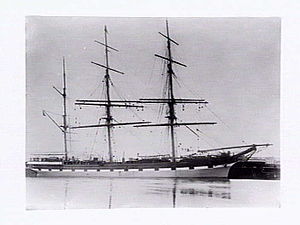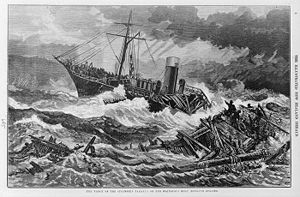 Each month in the Modellers Shipyard free monthly email newsletter we take a look at a Shipwreck from around the Australia and New Zealand.
Each month in the Modellers Shipyard free monthly email newsletter we take a look at a Shipwreck from around the Australia and New Zealand.
With its rugged coastline and immense inland river systems, Australia and New Zealand has an extraordinary maritime heritage. There are more than 6500 historic shipwrecks that lie beyond Australia’s shores. Each has a unique story and an important place in our heritage. These encompass convict transports, clipper ships, colonial trading vessels, steamships, harbour craft and much more. Each month we will take a look at a shipwreck from around Australia and New Zealand.
Loch Sloywas a Scottish sailing barque that operated between Great Britain and Australia from the late 19th century until 1899. Her name was drawn from Loch Sloy, a freshwater loch which lies to the north of the Burgh of Helensburgh, in the region of Argyll and Bute, Scotland.
In the early hours of 24 April 1899, Loch Sloy overran her distance when trying to pick up the light at Cape Borda and was wrecked on Brothers Rocks, about 300 metres from shore off Kangaroo Island, South Australia. Of the 34 passengers and crew on board, there were only four survivors, one who died from injuries and exposure shortly afterwards.
Loch Sloywas built in 1877 by D. and W. Henderson and Company, Glasgow, Yard No 178 for the Glasgow Shipping Company, more commonly known as the Loch Line.
Under the command of Captain Peter Nicol, Loch Sloy was on passage from Glasgow to Adelaide and Melbourne with a load of general cargo and seven passengers, including 2 women; David Kilpatrick, a cook from Glasgow (25), George Lamb, a clerk from Edinburgh, (30), Robert Logan, a piano tuner from Inverness, (40), Alexander McDonald, an engineer from Aberdeen (34), Captain Osmond Leicester (30) and Mrs Leicester, (Real name Mary Donally, 37. Osmonds real wife Fermina had been abandoned) (30), of Liverpool, and Rosalind Cartlidge (25). In the early hours of 24 April 1899, she met with disaster on the coast of Kangaroo Island at the mouth of the Investigator Strait, South Australia. The ship overran her distance when trying to pick up the light at Cape Borda. She was too close inshore and the light was hidden by the cliffs between Cape Bedout and Cape Couedie. In the darkness of the morning she ran full on to a reef 300 yards from shore to the north of the Casuarina Islets in Maurpetuis Bay.
The crew and passengers took refuge in the rigging, but one by one the masts broke and went over the side and the men were hurled into the breakers. There was little opportunity for her crew to save themselves. The ship had struck well off shore and only four men reached it – a passenger, two able seamen and an apprentice. None of the survivors remembered how they actually got ashore; they heard the crash of the masts, and then felt the wreckage bumping them about in the surf.
The four survivors, David Kilpatrick a passenger from Paisley, Renfrewshire, William John Simpson, the 19-year-old apprentice, and nephew of the captain, and two able seamen William Mitchell and Duncan McMillan, had to scale steep cliffs before they could even begin to get help. Kilpatrick was in a fearful state and could not climb up but eventually his companions helped him to the top, cutting his feet badly during the climb.
McMillan, the strongest of the survivors, left to find assistance, but after three days he had not returned, and the remaining three men decided to try to reach Cape Borda lighthouse. McMillan returned and finding the others gone, again set out for help, this time finding the May family, one of whom rode to the lighthouse where a search was organised.
The three other survivors were many miles from a settlement and were forced to survive on shell fish and dead penguins cast up by the sea. Unable to keep up with the others due to injuries and exposure, Kilpatrick was too ill to continue. The two others made him as comfortable Cape Borda Light station. They were without food, having given all they possessed to Kilpatrick, but the remains of two dead penguins were tied around their necks.
Mitchell subsequently stated that the ship was in fairly calm water half an hour before she struck. The boats might have been got out, but no attempt was made, the captain hoping to “bout ship” (change direction of the ship).
The body of David Kilpatrick was found nearly a month after the disaster. He was buried where found and his stone grave can still be seen today as a memorial to those who died in shipwrecks on Kangaroo Island’s west coast.
The ship’s wreck site is protected by the Commonwealth Historic Shipwrecks Act 1976
